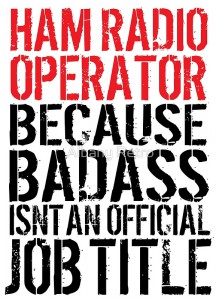 Now for another edition of Ham Radio Saturday.
Now for another edition of Ham Radio Saturday.
I created a page for the List of YOUR callsigns. HERE Chime in or drop me a note if your call doesn’t appear in the list.
I’ve been really busy lately, so I haven’t been able to do much radio stuff. There is good news about the radio shack, however. We have a date for clearing out the room where the station will be. That’s a step in the right direction.
Today, however, I went to a local tavern (my kind of place… reminded me a little of my first cooking job) where there is a regular Saturday meeting of hams. It was a nice group of people, which has been my overall experience of hams.
During the meeting, a couple of the people had brought things for show and tell. One of the things was 19th century book, about engineering windmills. In the book there was an amusing bit which was pointed out to me about a Catholic angle on who owns the wind!
“At the end of the fourteenth century, the monks of the celebrated but long since destroyed monastery of Augustines at Windsheim, in the province of Oversyssel, were delirious of erecting a windmill not far from Zwoll; but a neighboring lord endeavored to prevent them, declaring that the wind in the district belonged to him.
The monks, unwilling to give up their point, had recourse to the Bishop of Utrecht, under whose jurisdiction the province had continued since the tenth century. The bishop, highly incensed against the pretender who wished to usurp his authority, affirmed that the wind of the whole province belonged to him only, and in 1391 gave the convent express permission to build a windmill wherever they thought proper.” (From The Windmill As A Prime Mover by Alfred R. Wolfe, 1980, p. 50)
Another thing that was brought for show and tell was a cool little Chinese box for SDR, software defined radio. More about that at another time.
There was a good deal of radio talk. I understood about 10% of it, understood something of about 30% of it, and pretty much nothing about the rest. They were into the arcana of radio things like tubes… referring to numbers and models that seemed like entirely normal language to them. Anyway, it was interesting to clam up and listen to these people with decades and decades of experience.
I then went for lunch with two of the participants (who are parishioners and future members of the parish’s Statio Radiophonica) to a new Chinese place that has opened up near where I live, along side a Chinese grocery. I have been pretty disappointed in the Chinese food here in town, so I was eager to try this place. Going there will a couple more people provided an opportunity to try more dishes.
Here are a few shots, which I consider germane to a post on Ham Radio activities.
Eggplant in garlic.
San bei ji.
The shredded pork in garlic sauce was outstanding. There were a couple flavors in it that we couldn’t make out, but were enticing.
Great dumplings.
Really great spring rolls.
The light was filtering through Venetian blinds, but you get the idea.
I am delighted about this development.







































Aagh. The good old days. When I attended technical school in the Air Force I learned all about vacuum tubes: diodes, pentodes, tetrodes, grids, screen grids, cathodes, anodes, plates, filaments, suppressors. . .the good old days. And then transistors arrived with “N” and “P” doping material and a whole new universe arose.
It sounds like an excellent evening, Fr.Z. The top dish looks especially appetising, but did you realise that too much garlic in your food can seriously affect your spelling? [?] The delirious 14th century monks were well aware of that. [The delirious monks were nuns. Augustines, not Augustinians.]
Here is an exceptionally handsome neo-classical windmill for you and your friends to enjoy.
https://en.wikipedia.org/wiki/Chesterton_Windmill
In 1972 when I attended USAF Electronics school at Keesler AFB Biloxi MS the AF was still primarily using tube equipment for air to ground radios and ATC radars, so we had a lot of that. We had a number of ancient radios with motor generator sets sounding like miniature jet engines starting up, to provide the high voltage B+ for the tubes. Interesting times.
Jon
KC1EFW
Sign me up for the ham log
ve6ws
Alanmac
Tubes! I’m still running bottles here in my TS830 which has 6146 finals and a 12 series IPA…and my SB200 is running a pair of 572Bs. Nothing like the scent of warm tubes in a cool shack in the winter. Turn the lights down and let the filaments cast their glow on the desk.
Biggest set of tubes I ever ran was a 4CX15000A power ceramic being driven by parallel 4cx250BCs in an old commercial FM rig. Should have heard the noise when you hit the “Plate ON” button. Ker-CHUNK. All 10.2 kilovolts @2.6 Amps…you could FEEL the lights sag. Now, THAT’s RF. Nothing like it. Come to think it…I’ve been around RF of some sort that I’ve been generating on some device or the other since I was 13.
Guess that explains a lot…:)
No tubes have kind of taken the romance out of running a rig that you had to “dip and peak”. Dip the plate current to get the rig in resonance…and peak the load to match the transmission system. Now you just press a button, and some automaton clicks a bunch of relays and you’re good to go…
Another HAM (though not very active right now):
Richard Bonomo
WB2WXH
(an ancient type: ADVANCED class)
Most tubes are, also, hardened against EMPs.
The Chicken
Please add me to the ham list.
73,
W4CAN
[Done!]